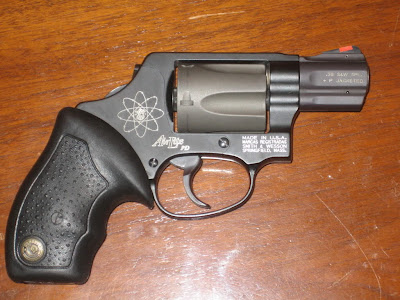Lot of guys out there know way more than I do about boomware, but I can sometimes translate it to a lay audience better.
We've mentioned that in gun power, bullet size matters. (So do velocity and projectile composition.)
So do the sizes of the slugthrowers.
The quick-and-dirty stat is this: Bullets come out of short barrels slower than they do long barrels, all things else being equal. This sounds counter-intuitive, but it's not, and here's why:
When the gun goes boom! expanding gases from the exploding gunpowder kick the bullet out the barrel.
As soon as the bullet and gases clear the muzzle, the marriage is on the rocks. The bullet goes on his way, the gases disperse, and it's Adios, bulleto.
With a longer barrel, the gases push the bullet longer in time, and thus faster.
So it is that a two-inch snubbie won't send it to the same velocity as a 4" standard barrel or a 6" target barrel. And a rifle in the same caliber will beat a pistol.
Pistols are trade-offs by nature. They give up knock-down power for a) portability and, in today's world, b) the ability to conceal a weapon.
If I were counseling you on a home defense weapon and you knew very little about guns? I'd tell you to get a 12-gauge pump shotgun. Lot of reasons, not the least of which is the sound of the round being chambered, chonk-chonk will scare the pee out of anybody who hears it and knows what it is.
Hmm. Maybe that house down the street would be a better place to burgle if some fool with maybe an itchy trigger finger is coming down the hall with a fucking shotgun!
In the earlier discussion on mouse guns, I explained why smaller was sometimes more useful: Small gun in a situation requiring a gun is better than no gun.
I prefer revolvers, but a two-inch J-frame snubnose with most ammo has a single-shot stopping rate of around 66-68%. What this means is, you shoot somebody one time to the body, they cease and desist that many times out of a hundred. (There are ammo exceptions, but let them be for now.)
Best fight-enders among common handguns: .357 Magnums and some of the .40 S&W's and hot-loaded 9mm's. Nobody knows what a .500 Max will do 'cause nobody's gotten shot with one yet, and some of the .44 Magnums go right through before they expand, without dumping most of their energy into the target. You still don't want to get shot with one, and if the bad guy has seen Dirty Harry, that might go a ways to calming him down.
With rifles and expanding bullets that dump big energy into a target, that number approaches 100%, though it's kind of like Zeno's Paradox about Achilles and the tortoise ...
Let that go. Also let go the notion that you get into a gunfight and you are only going to shoot somebody one time and then look carefully to see what he does next. Come the moment and somebody charging you with a knife or baseball bat or shooting at you, unless you are carrying a cap-and-ball dueling pistol, you are going to shoot more than once, and to one of two ends: A) The assassin charging you falls down and desists from further aggressive action, or B) You run out of ammo. If you hit him all those times and he keeps coming? Throwing the gun probably won't do you any more good than it would throwing it at Superman.
Guns are not magic wands. They don't always stop everybody every time.
I haven't seen the statistics on the increase or decrease in stops if you shoot somebody two, three or nineteen times, but in my heart, I believe that the more lead downrange that connects, the more likely that a stop will occur, adrenaline-fury and PCP notwithstanding.
Back to the J-frame. So this is a five-shot revolver and with the best ammo, probably around a 68% stopper.
The .380 ACP mouse gun is actually a slightly better one-shot stopper, the best rounds at around 70%.
Why? Generally, the barrels are a bit longer, and the action allows less of the propellant gas to escape than a revolver's cylinder gap, so the bullet, which is essentially the same diameter as the .38 Special, scoots out a little faster than the snubby generates.
Another trade-off here is that semi-autos in this caliber are finicky about ammunition and will sometimes jam. Generally, it is considered a good idea to fire 200 rounds through any pistol you plan to carry for defense, and until you find a round it will do that with without any jams, you don't trust it.
.380 ACP ammo is expensive. It might cost you a couple hundred bucks to get something your gun loves.
A pistol that jams on the second round is the same as dueling pistol. You don't have to do as much to maybe get a second round chambered, but you might have to rack-and-tap, and you have to do something.
Mostly with a J-frame revolver, you give five for sure.
Then again, if you find one a .380 that works for you as it should, you usually get six or seven cartridges, sometimes even 7+1, which is three more than the J-frame, and you can carry it in your jeans pocket ...
Decisions, decisions.
I hope I cleared this up for you ...
